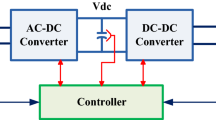Abstract
This paper discusses a converter structure appropriate for charging the batteries of an electric vehicle. The structure is obtained by a transformation of a conventional three-phase inverter, which is already present in an electric vehicle’s powertrain system. Since the motor inverter’s semiconductor components and the electric motor’s windings form the battery charger’s circuit, a reduction in the powertrain system’s size and weight is achievable. The proposed fully integrated battery charger can operate in buck and boost modes, while providing power-factor correction capability continuously. This paper also proposes an input current control strategy which ensures smooth operating mode transitions, which occur during the operation of the battery charger. The control is entirely implemented within a microcontroller and ensures operation with a high power factor and low total harmonic distortion of the input current. The performance of the discussed converter using the proposed control scheme was verified experimentally.
















Similar content being viewed by others
Notes
\(T_\mathrm{s} =100~\upmu \)s and represent the PWM switching period.
Object parameters are: winding inductance \(L = 20\) mH, winding resistance \(R_L = 4~\Omega \) for current controller design and instead of battery the output capacitance \(C= 220~\upmu \)F and output resistance \(R_N \in (100,300~\Omega )\) were chosen in order to design the voltage controller.
Texas Instruments’ microcontroller TMS320F28335.
\(U_\mathrm{ref}=200\) V.
\(R_N=300~\Omega ,~R_N=200~\Omega ~\text{ and }~ R_N=100~\Omega \), respectively.
References
Auda M, Milanovič M, Roškarič A (1999) Battery charger based on double-buck and boost converter. In: Proceedings of the IEEE international symposium on industrial electronics, ISIE’99, pp 747–752
Wu D, Chen H, Das T, Aliprantis DC (2008) Bidirectional power transfer between HEVs and grid without external power converters. In: IEEE energy 2030 conference, pp 1–6
Monteiro V, Ferreira JC, Meléndez Andrés A, Nogueiras M, Afonso JL (2013) Electric vehicles on-board battery charger for the future smart grids. In: Doctoral conference on computing, electrical and industrial systems, DoCEIS 2013, Portugal, April 15-17, 2013. Proceedings. Springer, Berlin, pp 351–358
Bertoluzzo M, Zabihi N, Buja G (2012) Overview on battery chargers for plug-in electric vehicles. In: 15th international power electronics and motion control conference, EPE-PEMC 2012 ECCE Europe, Novi Sad, Srbija, pp LS4d.1-1–LS4d.1-7
Haghbin S, Lundmark S, Alakla M, Carlson O (2013) Grid-connected integrated battery chargers in vehicle applications: review and new solution. IEEE Trans Ind Electron 60(2):459–473
Dusmez S, Khaligh A (2013) A compact and integrated multifunctional power electronic interface for plug-in electric vehicles. IEEE Trans Power Electron 28(12):5690–5701
Liu S, Hahlbeck S, Schoenen T, Hameyer K (2013) An integrated on-board charger with direct grid connection for battery electrical vehicle topology and system efficiency analysis. In: International symposium on power electronics, electrical drives, automation and motion, Sorrento, Italy, pp 335–340
Su GJ, Tang L (2013) An integrated onboard charger and accessory power converter for plug-in electric vehicles. In: IEEE energy conversion congress and exposition, pp 1592–1597
Karaarslan A, Iskender I (2011) A DSP based power factor correction converter to reduce total harmonic distortion of input current for improvement of power quality. Electr Eng 93(4):247–257
Prodić A, Chen J, Erickson RW, Maksimović D (2003) Self-tuning digital comb filter for PFC applications. IEEE Trans Power Electron 18(1):420–428
De Belie FMLL, Van de Sype DM, De Gussemé K, Ryckaert WRA, Melkebeek JAA (2007) Digitally controlled boost PFC converter with improved output voltage controller. Electr Eng 89(5):363–370
Author information
Authors and Affiliations
Corresponding author
Additional information
Publisher's Note
Springer Nature remains neutral with regard to jurisdictional claims in published maps and institutional affiliations.
Rights and permissions
About this article
Cite this article
Truntič, M., Konjedic, T., Šlibar, P. et al. Integrated single-phase PFC charger for electric vehicles. Electr Eng 100, 2421–2429 (2018). https://doi.org/10.1007/s00202-018-0714-8
Received:
Accepted:
Published:
Issue Date:
DOI: https://doi.org/10.1007/s00202-018-0714-8




